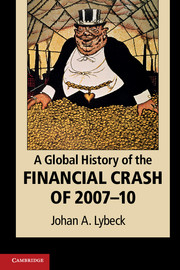Book contents
- Frontmatter
- Contents
- List of figures
- List of tables
- Preface
- Acknowledgments
- Abbreviations
- 1 Introduction
- 2 Financial crises in the USA and Europe, but not in Asia
- 3 Could today’s financial crisis have been foreseen?
- 4 The US housing market and the subprime crisis
- 5 Securitization and derivatives spread the crisis around the world
- 6 Liquidity risk aspects of the crisis and a comparison with 1907 and 1929
- 7 Credit risk aspects of the crisis, rating and solvency
- 8 Financial crises in modern history
- 9 Worldwide changes in regulation and supervision as a result of the crisis
- 10 Outstanding issues
- Bibliography
- Index
- References
5 - Securitization and derivatives spread the crisis around the world
Published online by Cambridge University Press: 05 June 2012
- Frontmatter
- Contents
- List of figures
- List of tables
- Preface
- Acknowledgments
- Abbreviations
- 1 Introduction
- 2 Financial crises in the USA and Europe, but not in Asia
- 3 Could today’s financial crisis have been foreseen?
- 4 The US housing market and the subprime crisis
- 5 Securitization and derivatives spread the crisis around the world
- 6 Liquidity risk aspects of the crisis and a comparison with 1907 and 1929
- 7 Credit risk aspects of the crisis, rating and solvency
- 8 Financial crises in modern history
- 9 Worldwide changes in regulation and supervision as a result of the crisis
- 10 Outstanding issues
- Bibliography
- Index
- References
Summary
MBSs and CDOs
Until the mid 1980s, a lending bank had several roles to play in the lending game. It held the contact with the customer and had made the evaluation of the customer’s creditworthiness – that is, his or her ability to repay. It collected interest and amortizations from the borrower. It had also funded the loan, most often by its own short-term deposit taking. Since the deposit interest rate was most likely variable, while the lending rate was fixed, it had a built-in interest rate (maturity) risk which had to be handled. It also had a liquidity risk if depositors wanted their money back on top of the obvious credit risk on the borrower.
The first transaction to move the credit risk from the originating bank to investors was actually already undertaken in 1970. In February of that year, the government-owned Government National Mortgage Association (GNMA, “Ginnie Mae”) issued mortgage-backed securities (MBSs) backed up by a portfolio of underlying residential mortgages. This first deal led to a formal explosion of credits being securitized.
- Type
- Chapter
- Information
- A Global History of the Financial Crash of 2007–10 , pp. 141 - 170Publisher: Cambridge University PressPrint publication year: 2011

